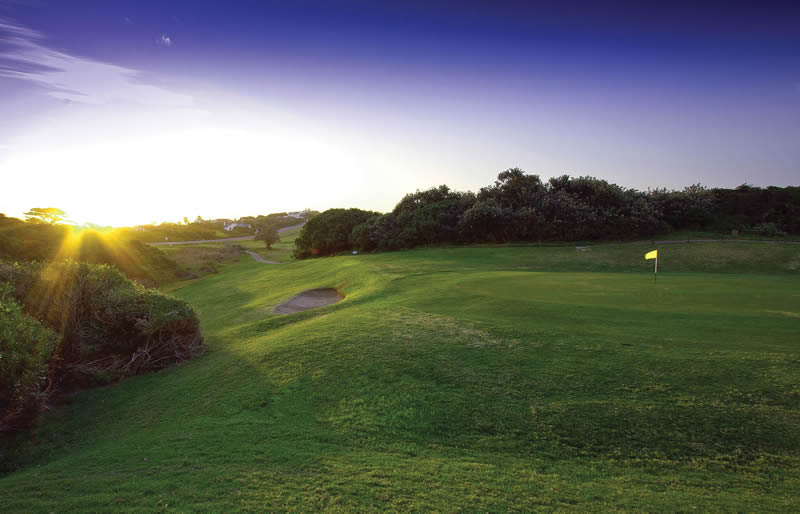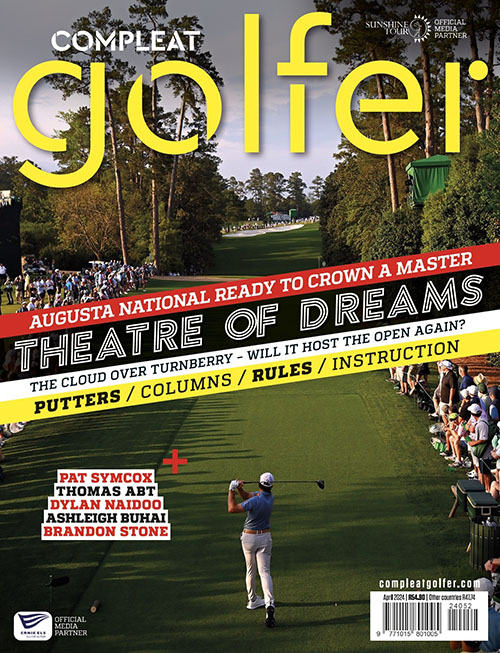Nestled on the slopes overlooking the Indian Ocean in one of the Eastern Cape’s premier holiday destinations, South Africa’s fourth royal course can be found. Situated on land once farmed by 1820 settlers, this course, with its rich history, is a delight to play and leaves one with a desire to return the very next day.
History of Royal Port Alfred
It was back in 1923 that William Rose addressed a business gathering regarding the development of Port Alfred with this tribute that is still true today: “The course remains a monument to the origins of golf as a game played on a South African links by the southern sea. In the beginning it knew no architect but nature, and on no other South African course is the hand of man less evident.”
Royal Port Alfred comprises a variety of holes, rising and falling with the lie of the land and speckled with thick coastal bush that is always willing to accept a stray ball. The course originated with the coming together of five local visionaries: two doctors, two hotel owners and an investor. In 1906, the club was conceived and in 1907, sponsors were invited to participate in the venture. These five brave men each contributed the handsome sum of £20 to cover the initial work as well as a room to rent. Dr Atherstone was the only golfer among the five and laid out the route for the first nine holes. On 25 April 1908, the course was opened, boasting a full 18 holes, and hosted a three-day tournament with prizemoney of £30. By 1915 a clubhouse was built, and today’s renovated clubhouse can still be found in the same location.
Over time, the course has undergone numerous changes and upgrades, one of which, completed in 1915, resulted in a par of 76, with the layout boasting no fewer than eight par fives. The course has always been particularly popular and in 1919 a total of 16 782 rounds of golf were recorded.
A visit in April 1921 by Prince Arthur of Connaught began the royal affair, and Port Alfred subsequently hosted the 1922 SA Golf Championship. On a visit by Edward, Prince of Wales, in February 1924, the status of ‘Royal’ was bestowed on the course. An anecdote worth mentioning is that during another royal visit in 1925, upon reaching the tee of the par-four 12th hole, Prince Edward was so impressed with its proximity to the ocean that he tried to reach the sea with a few drives. The fact that it was over 600 yards away meant he was not successful, but one of the balls, later found by a local, still sits in the clubhouse.
In true links style, the course’s severity is dictated by the weather. When the wind is down, which is not very often in the Eastern Cape, the course is short and benign. When the wind howls, the links-like characteristics come to the fore.
Much of the course’s history is etched on the scorecard as many of the holes are named after relevant people involved in the history and development of this great links. What you won’t find on the card is mention of the numerous antelope you can spot loitering on the fairways during your round, which is yet another reason for a visit.
Royal Port Alfred course guide
With four par fours of less than 300 metres, a good score is in the offing for the accurate wedge player. But rolling fairways seldom allow for a flat stance, making the demanding approach shots to generally small greens even more difficult. The first four holes, all par fours, allow you to warm up and get into the swing of things. They are all relatively straight, with little rough, and apart from the 2nd hole, ‘Hippo’s Bath’, they are rather unintimidating. The 2nd has a large depression just short of the green that used to hold water, and the discovery of hippo tusks in the vicinity is how the hole earned its urban legend-like name. The green of the 3rd deserves a short rest to allow golfers to enjoy the vista of the Indian Ocean, with a 180-degree panoramic view of the houses and beaches that make up the popular seaside town of Port Alfred.
From the stroke-2 5th hole, the difficulty of the course suddenly increases. A blind tee shot into predominantly head- and crosswinds, if accurate, leaves you on a severely downward-sloping fairway towards the green. A new water feature at the back left of the small green increases the difficulty of finding it and making par. A short par three follows and, despite being only 126 metres in length, ‘Happy Valley’ has left many a golfer bemused and rather upset. A small depression short of the hole, with thick coastal bush encroaching on the left, creates a visually intimidating target. The following par five, ‘Shelley Beach’, runs parallel to the ocean and although straight, it has to rate as a 10 on the knee-knocker scale. A severe left-to-right sloping fairway has thick bush on both sides. Your second shot, whether laying up or going for the well-bunkered green in two, is blind. If the westerly is up, reaching the green in three is a feat on its own. A small halfway house is available after the 8th hole, a stunning par three from an elevated tee that offers only a partial view of the green. Visitors may struggle with club selection here too, as the tee-box is sheltered from any wind.
Following the 455-metre par-five 9th is the aptly named ‘Whale’s Back’ 10th hole that never seems to play the same from day to day. A par four of only 326 metres, the fairway slopes massively from left to right, making the drive to the short stuff particularly difficult. Trying to stay on the left-hand side of the fairway for a flat lie brings severe rough into play, but if you bale out, your ball rolls all the way to the right side of the fairway or the rough beyond it. From this position, an approach to an elevated green takes nerve and a bit of luck, with the putting surface well protected by bunkers.
The next two holes make up the essence of this course. The par-three 11th of 168 meters has ruined the score of numerous monthly medal contenders. Again influenced by the wind, a wood or wedge may be required to reach this green that resembles a punch bowl. A push right is the norm due to heavy bush and a steep slope on the left, and with the lie of the land coaxing the ball back onto the green, the perfect fluke is always a possibility. Walking to the 12th through a pathway of coastal bush and emerging onto an elevated tee-box reveals views fit for a prince. The ocean looks only a stone’s throw to your right and the clubhouse and rolling fairways to your left provide reason as to why the Prince of Wales had a soft spot for the area. The required tee shot will snap you back to reality, as it requires a carry of approximately 60 meters of bush to reach a dogleg-right fairway with thick bush on the right. Approaching the well-bunkered green, again with bush to the right, takes a well-struck medium- to long-iron. This hole is worthy of its ‘signature hole’ tag.
The final four holes will tire even the fittest golfer as they stretch up and down the meandering grassy hillocks. The short par-four 15th is a steep uphill that transforms into a monster if the easterly is blowing, while the stroke-1 16th can be treacherous at the best of times. The uphill par-four 17th is similar to the 15th and has a severely sloping fairway and tough green. The final hole, a 474-metre par five, can be a well-deserved respite from the easterly wind or the final nail in the coffin if the westerly is up. An elevated tee looks down to a severely rolling, yet wide fairway that makes for a relatively easy target. Most golfers can’t reach the small green in two, while the wise golfer chooses not to, as the steep bank to the right has bogey or worse written all over it.
The massive, well-stocked bar overlooking the course has a great atmosphere and always has a token member to keep you company, especially during holiday season, when the course is busy. A round on this enchanting layout will leave you mentally and physically taxed, yet nourished on the deepest level. Like a good novel, it leaves a tangible and long-lasting impression.
Likes
■ Feels like home.
■ Well priced.
■ Friendly and helpful staff.
■ Some of the best views on a golf course.
■ Abundance of wildlife.
Dislikes
■ Condition of the greens can at times be suspect.
■ Some tee-boxes need
flattening and aligning.
■ Caddies shouting over the fence on arrival.
■ Quality of bunker sand.
Royal Port Alfred Factfile
Getting there
From the R72 coastal road (connecting Port Elizabeth and East London), turn south-east into Atherstone Road. After 1.1km, turn right into Princess Avenue. The golf club will be in front of you.
Course
Par 72, 5 739 metres.
Contact details
046 624 4796
[email protected]







